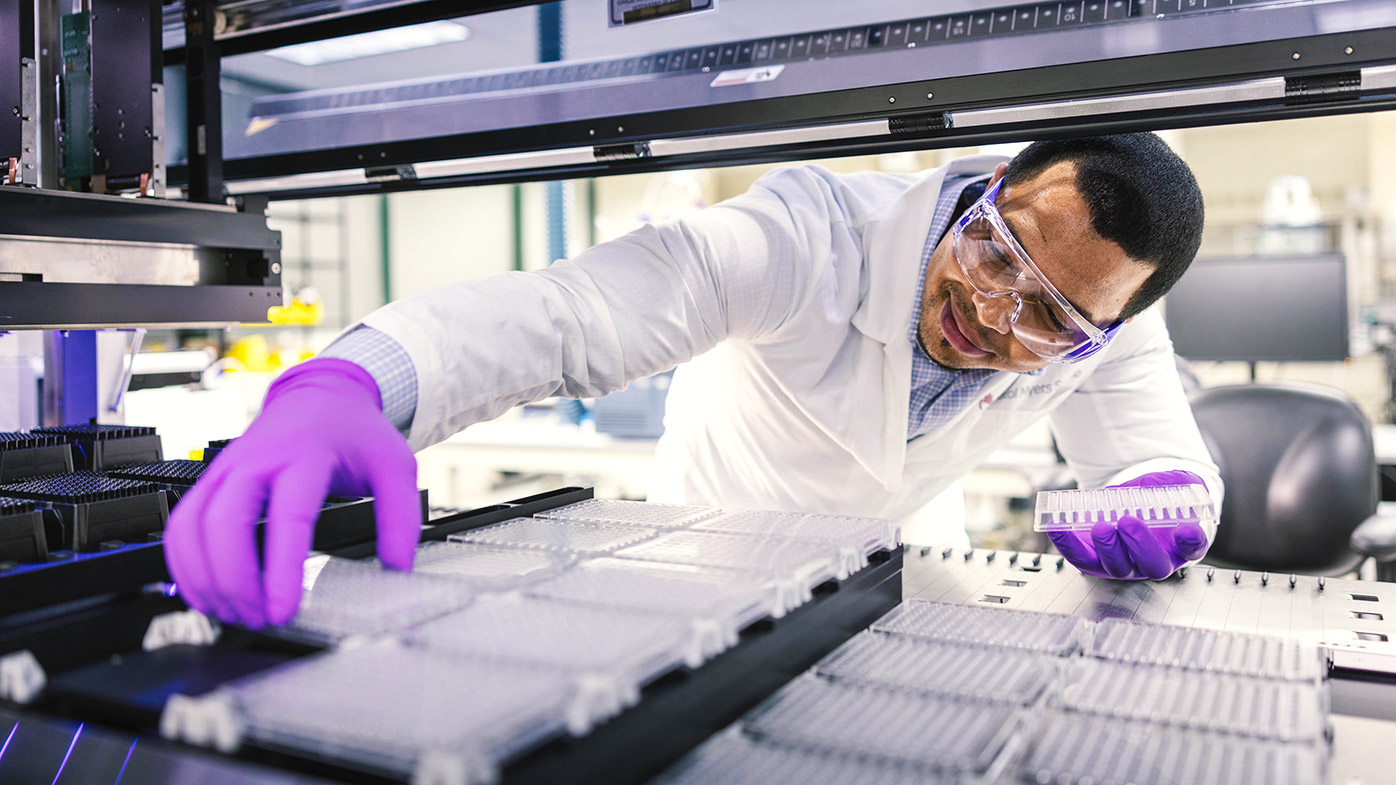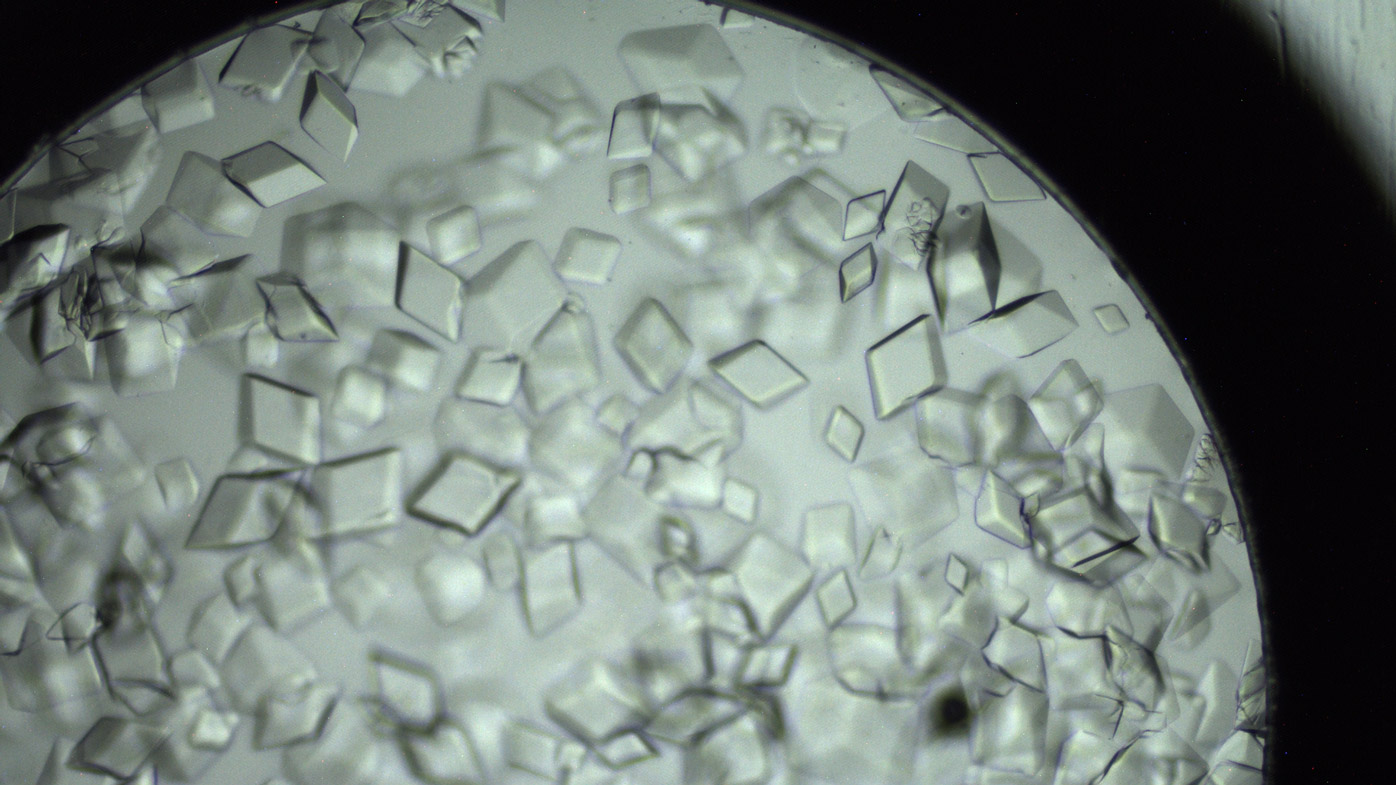Celebrating women in STEM: The sky’s (not) the limit
A team of researchers sending our experiments to space includes several women who are redefining what it means to be a scientist. In celebration of Women’s History Month, we share their stories.
When Christina Cuttitta was offered the chance to do research that would take her experiments to the International Space Station (ISS), she was excited to say the least. “It’s not every day that you’re asked, ‘Are you interested in participating in a project that’s not going to happen on Earth?’”
Cuttitta, senior associate scientist, Molecular Structure and Design, Small Molecule Drug Discovery, is part of a team of researchers who are working to identify the ideal conditions for high-quality crystals to form in microgravity.
Protein crystals grown in microgravity are often larger and more uniform, which makes them better candidates for collecting data. This gives us a better understanding of the structures of potential drug targets that are difficult to obtain from Earth-grown crystals. That could lead to a more efficient manufacturing process for therapeutics, and positively impact the treatment landscape for many of our patients.
In 2020, the team saw their work take off from the John F. Kennedy Space Center in Florida and travel to the ISS National Lab (ISSNL), where partner astronauts replicated their experiments and studied crystal growth over the course of a monthlong mission.
Now, our second mission is underway; after thousands of tests at labs in New Jersey and California, a Falcon 9 rocket launched on March 14 carrying our experiments into space. Read more about that work here.
For the first mission, Cuttitta was the only woman on the four-person team. But this time, she is joined by Tamar Rosenbaum, associate scientific director, Materials Science & Engineering, and Barbra Pagarigan, senior scientist, Protein Homeostasis, Structural Biology.
The team’s makeup speaks not only to the slow but steady progress worldwide toward gender parity in STEM fields, but also to company's commitment to inclusion and belonging in the name of better science. “This group has bright and dedicated scientists, gender aside,” said Cuttitta. “The fact that it includes more women this time around is icing on the cake.”
Cuttitta, Pagarigan and Rosenbaum have tread very different paths to reach where they are today — working together on a project beyond our planetary boundaries and toward a goal much bigger than themselves.
Christina Cuttitta, Senior Associate Scientist, Molecular Structure and Design, Small Molecule Drug Discovery
In 2020, Cuttitta watched from her living room as the rocket containing her team’s research launched into space. The rest of her team was there in Florida, but Cuttitta had a reason for staying behind — she was nine months pregnant with her first child.
“I was sad I couldn’t join my team and attend the launch in person,” she said. “But as I sat on my couch holding my belly and feeling my daughter kick while watching the livestream of the rocket taking off with the science that I had prepared, I realized being there in person didn’t matter. What mattered was that I was going to be a new mom and one day I could tell my daughter the story of how I participated in the research, and the impact of my contributions to the mission.”
This year, though she is expecting again, Cuttitta was able to attend the launch. But now she faced a new challenge: leaving behind her daughter for the first time.
These are the ups and downs of motherhood in parallel with a demanding career in STEM, Cuttitta acknowledged, but she wouldn’t have it any other way.
Cuttitta’s mother instilled in her daughter at a young age the importance of a career. Cuttitta is the first female college graduate on her mother’s side, a badge (like the NASA mission patch our researchers received) she wears proudly. She followed her undergraduate degree in biology with a graduate degree in neuroscience and took on a brief fellowship in protein crystallography, which eventually led her to BMS.
What first attracted her to the company in 2018 was the tenure of the members on her prospective team, and that the leadership was female.
“If someone has been working for a company for 10-15 years, it means they are really happy being there,” Cuttitta said. “When I realized that my two upper managers would be female, I could see the inclusive culture of BMS, as well as the opportunities and potential I would have as a young female scientist. It was like the BMS' commitment to gender diversity had already been broken.”
Only a few years into her time at BMS, Cuttitta was tapped for the space mission project and immediately said, “Sign me up.”
“It was inspiring that BMS was supporting this innovative work to bring forth leading medicines. To be asked to contribute my expertise and take part in this type of research as a young female scientist was incredible — it’s certainly a career highlight for me,” she said. “But more than that, I hope one day my daughter and other young women can look at my path in the STEM field and say ‘I could do that, too.’”
Cuttitta and her husband will welcome a son this July.
Barbra Pagarigan, Senior Scientist, Protein Homeostasis, Structural Biology
Barbra Pagarigan, who goes by Bee, says the lab is her playground. “The people, the gadgets you work with, and then the actual protein crystals are really awesome,” Pagarigan said. “It’s like no other job.”
Space to play and be active is what she seeks: Pagarigan says she has always been connected to adventure and the outdoors. She built her own cabin in the mountains of southern California, and now she’s building a tiny home in San Diego. She’s an athlete, too: Olympic weightlifting and hiking are her sports of choice these days, but she has spent years on the soccer field. In the lab in San Diego, her teammates are robots.
“I just love the idea of robots trying to do human things, but not being very good at it,” she said with a laugh. “You still need to babysit them.”
The robots help Pagarigan run literally thousands of experiments each week to prompt a handful of proteins to crystallize. She says her athleticism and competitiveness kick in in the race to crystallize proteins.
Pagarigan, who joined BMS in 2019 with the acquisition of Celgene, has been working in crystallization for over 20 years — she has been in biotech for over 30. All that time her north star has remained constant; the loss of her mother to cancer when she was in college guided her toward a career of service in science.
That intention has propelled her throughout her career. Now as the veteran, she challenges younger women scientists to get attuned to what really drives them rather than what might be expected of them. She challenges them to be bold.
“I still see younger women hesitant to speak out, or they question their roles, or they don’t ask for that promotion,” she said. “They’re trying to fit into a box, and I wish they would create the space for who they authentically are.” BMS has continued to lead in that space, she said, where she never expects to be held back as a woman in STEM.
Pagarigan said she couldn’t ever help but be herself, even as a kid.
Despite her mother’s reservations about her daughter playing sports, Bee told her parents she needed athletics to maintain her mental health while dealing with a parent who was seriously sick at home. During high school in Tiffin, Ohio, she joined an all-boys soccer team. She was also the first girl to take industrial arts class, as opposed to the more typical choice for girls — home economics.
“I just wanted to do what made me whole,” she said. “It wasn’t about conquering stereotypes or making a stand. I just really knew I wanted to do it. Sure, there were barriers, but it was more important to be true to myself.”
Tamar Rosenbaum, Associate Scientific Director, Materials Science & Engineering
When Tamar Rosenbaum was in high school, she really enjoyed science class, but she admits that her impression of the field was “the lone scientist in the lab with all his chemicals.”
“That’s totally a misconception,” she said.
Rosenbaum is a case in point: sure, she spends time in the lab, perhaps observing the uniformity of a batch of crystallized proteins. And when she goes home, she’s mom to nine children — ranging in age from 3 years old to 17, and including one set of twins.
It takes some organization and time management, of course. Rosenbaum said her husband, who works closer to home, pitches in a lot, as do her older children. “If you’re organized, you have your priorities and you know what you want to do, then you can make it work.”
Greater flexibility since the pandemic has also helped, Rosenbaum said. If she has an early morning meeting, she can take it from home while the kids are getting ready for school. What’s also improved in the more than 10 years she has worked at BMS, she said, is the maternity leave.
“When I first started, six weeks after having a baby I had to go back to work,” she said. “That has changed a lot, and it’s made a huge difference.”
Rosenbaum has seen other ways BMS has committed to gender diversity. “The company does a good job of making sure that there’s women in leadership roles,” she said. “That sends a trickle-down message and sets the culture as a whole.”
She said it’s an empowering place to work – a place where she gets to interact with many other women scientists, like Cuttitta and Pagarigan, and a place where she said she never felt overlooked or dismissed for being a woman.
And that kind of environment allows her to focus on the science.
“I love being able to take an understanding of the world and then use that to solve a problem that we’re having in a practical way,” she said. “The work itself is very meaningful, to think that what you’re doing is ultimately helping make a better product for patients.”
Rosenbaum is proud to set an example for her children of what’s possible for them. One day, one of her sons came home from school and asked her if she really is a scientist. A classmate had told him that his mom couldn’t be a scientist – that “scientist” is not a real job.
“It is too a job, and you tell them anyone can be a scientist,” was her reply.
Subscribe to Our stories alerts
Beyond just relevant information about Bristol Myers Squibb's therapeutic areas and innovation, Our stories offer a window into the work our employees do every day for patients.
About Bristol Myers Squibb
Bristol Myers Squibb is a global biopharmaceutical company whose mission is to discover, develop and deliver innovative medicines that help patients prevail over serious diseases. As global citizens, we work sustainably and responsibly to create a positive impact in the communities where we live and work.

